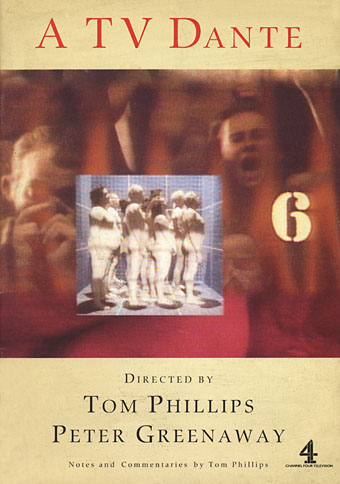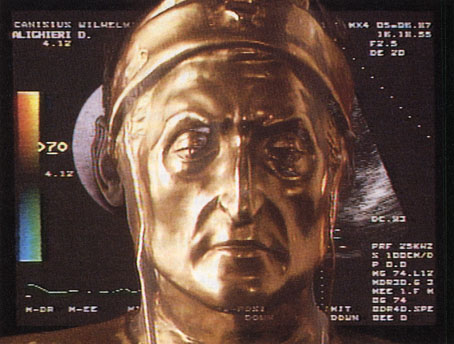More cult stuff from Ubuweb, you lucky people. Being a big Tom Phillips enthusiast I’ve been watching A TV Dante (1989) for years, having taped the one and only broadcast of the series. I also bought the accompanying booklet (below).
This ambitious program, produced by the award-winning film director Peter Greenaway and internationally-known artist Tom Phillips, brings to life the first eight cantos of Dante’s Inferno. Featuring a cast that includes Sir John Gielgud as Virgil, the cantos are not conventionally dramatized. Instead, the feeling of Dante’s poem is conveyed through juxtaposed imagery that conjures up a contemporary vision of hell, and its meaning is deciphered by eminent scholars in visual sidebars who interpret Dante’s metaphors and symbolism. This program makes Dante accessible to the MTV generation. Caution to viewers: program contains nudity. (8 segments, 11 minutes each)
Given the nature of the collaboration, this can’t be compared to many other TV productions. Greenaway wasn’t staging a drama, he was using the TV screen as a flat space like a moving painting, or a series of diagrams and connected symbol systems. The division of the screen has a parallel in some of Phillips’s paintings (and his artist’s book of the Inferno) and makes use of Phillips’s familiar stencil lettering. There are actors: as mentioned above, Sir John Gielgud took the role of Virgil, with Bob Peck as Dante and Joanne Whalley-Kilmer as Beatrice. And there are recurrent motifs: triangle, concentric circles, cardiograph displays, Muybridge animations and so on. “Footnotes” were provided by a company of experts who appear in small inset panels to comment on the text while it’s being read. Phillips himself is one of the principal commentators since it was his translation being used.

Peter Greenaway’s feature films have never interested me very much, I prefer him when he’s doing things like this which probably explains why I like Prospero’s Books, his version of The Tempest; much of that film’s approach seems to have been developed from A TV Dante. It’s a shame that only eight of the Cantos were filmed in this way. There were plans to film all thirty four using other directors (with Greenaway to return at the end) but this endeavour took place at the end of the period when Channel 4 was still a haven for unusual arts projects. Regime change subsequently charted a course for the lowest common denominator. And with the two leading actors now dead it wouldn’t be possible to resume the project. In the end this doesn’t matter too much. What remains is an introduction to a perennially fascinating book and an example of how television could—if someone had the courage—ditch the clichés of drama documentary and try something genuinely new.
• The official Tom Phillips website
• The Tom Phillips blog
Previously on { feuilleton }
• John Osborne’s Dorian Gray
• 20 Sites n Years revisited
• The last circle of the Inferno
• 20 Sites n Years by Tom Phillips


I think you are being too hard on Peter Greenway’s films. I have seen the majority of them and I think as an artist you should give them a second look. The movies are filmed with a painter’s eye as the camera lingers over each detail with meticulous care. The scenes in the movies are staged like an artist’s models in a studio. He is one of the few filmmakers that do “period movies” in a totally convincing way. I would add Stanley Kubrick’s “Barry Lyndon” as a movie that is a time machine.
I would recommend 2 of Greenaway’s movies: “The Belly of an Architect” & “The Draughtsman’s Contract.” They are both so marvelously photographed with such rich color and detail that you will be unable to look away. The plots both about an artist’s self destruction; the “The Belly…” about the opening of an exhibition on the work of Etienne-Louis Boulee and the “Draughtsman…” about ant artist hired to produce drawings of an estate in 18th Century France are both alarming and inevitable.
Hi Richard. I’ve seen nearly all of Greenaway’s major productions–up to and including The Pillow Book–and in theory should be his ideal audience since I’m very familiar with the art and architecture references, enjoy the music (Prospero’s Books has a superb score) and appreciate his influences (Alain Resnais in particular, from whom he swiped a cinematographer in Sacha Vierny). But with a couple of exceptions they don’t engage me.
This is a big debate but I don’t find Greenaway’s films to be successful in providing a suitable alternative to what he calls “dominant cinema” (ie: Hollywood). He complains about cinematic theatricality and “the tyranny of text” yet seems to have little to offer beside a procession of beautiful tableaux. I can admire the tableaux–there’s often much to admire–but the end result doesn’t satisfy. I don’t feel I’ve been given an insight into anything beyond a look at Peter’s obsessions of the moment.
Should art always offer insights? Of course not, and I have plenty of time for art that doesn’t; these pages of mine have an “abstract cinema” category, after all. The hazard for art which is highly formal, as Greenaway’s is, which conveys little beyond its formality, is that it risks becoming mere decoration. As Francis Bacon said about Mark Rothko, you feel as though you could order up several yards of it.
I always feel bad about criticising Greenaway since he suffers from a great deal of inane and glib dismissal and I do believe he’s a valuable artist. I’d rather there were more people around being as bold as he’s been instead of continually ladling CGI onto a thin adventure plot. I just wish I could be more enthusiastic about his works; I’ve tried and I can’t.
I saw ‘A TV Dante’ at school. It was remarkable, and has stayed with me.
I have a trade copy of Tom Phillips’ “Inferno.” I always felt his illustrations were Tom’s Inferno and had nothing to do with Dante. Dante begs for realism. Of course the modern picture of the Inferno owes is visualization to Gustav Dore. I purchased a very early copy of his book in an elaborate Victorian binding with the wood engravings full size. I assume they were printed from the original blocks. While it could be argued that his illustrations are too literal, I think Dante was trying his best to give us a clear photograph of his experience. Even though Virgil was shielding him from the violence, the smell of brimstone, excrement and unwashed bodies must have been overwhelming; I must not fail to mention the devil’s farts and bad breath. His dedication to realism [besides revenge] is one of the chief reason he put some of his contemporary “Ghibeline’ enemies in a few of the circles. Obviously, Dante did this to say “you are going here, not me.” Dore illustrated the complete Divine comedy but the Inferno works hold the most interest. As the main protagonist is often quoted “it is better to rule in hell than serve in heaven.”
I wanted to mention that I purchased a “La Divina Commedia” several years ago that was published by Instituto Geografico de Agostini in Novara [in the Piedmont region of Italy]. This book published on 1943 during the allied invasion of Italy; you would think that they had more pressing matters. It has 105 pre-Raphaelite influenced paintings by an obscure artist G.B. Galizzi. The illustrations have a vivid realism added to a visionary imagination. I got this book many years ago from a dealer here in New York. I wonder how many copies survived the war and what other books this Galizzi illustrated.
You know I’m a big Greenaway fan, have many of his films on dvd and even saw him speak once. I do understand why people don’t care for his work, but ultimately it’s a matter of personal taste. I thoroughly enjoy his output, and could go on about it at great length but will spare you the essay. Anyway, good post!
I have done some cut-up videos to Cabaret Volltaire songs, two of which feature futage from the ‘TV Dante’.
I’ve tried to keep them pretty much in the style of the video that The Cabs used to do themselves, and I’d like to think if you didn’t know, you’d assume they were long-lost promos made by the band themselves.
(Exract from) Chance Verses Causality: http://www.youtube.com/watch?v=lGC3250Zflc&feature=related
4th Shot: http://www.youtube.com/watch?v=ufOGT238jVM&feature=related
Mussolini Headkick: http://www.youtube.com/watch?v=hxsYrfKf_pc
Heaven and Hell: http://www.youtube.com/watch?v=7g-2HW_2TbI&feature=related
Futage? I mean ‘footage’. Obviously.